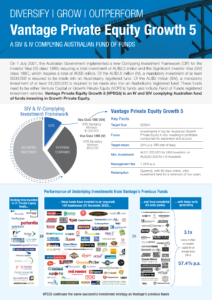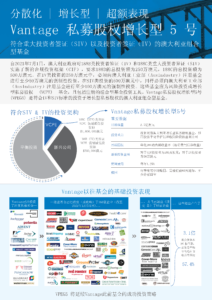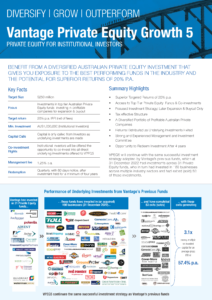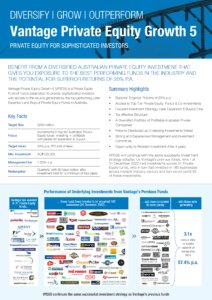Australian Private Equity Well Positioned to Outperform
With Australia entering its first recession in 29 years as a result of the slowing economy caused by the COVID-19 restrictions, it is timely to compare the historical performance of the Australian & New Zealand Private Equity market across all time frames, to the performance of those Private Equity funds that were established during, or otherwise invested across, previous recessionary periods.
Summary statistics provided by AVCAL & Cambridge Associates reveal that the median and upper quartile net returns from Private Equity funds formed in Australia and New Zealand, between 1997 and 2018, focused on the later expansion and buyout financing stage, in which Vantage funds invest, was 11.1% p.a. and 20.3% p.a. respectively. These robust returns demonstrate Private Equity’s ability to consistently outperform public markets as the return on the S&P ASX 200 Accumulation Index over the corresponding period was only 8.4% p.a.1.
However, during periods of economic contraction, the performance of Private Equity was even more pronounced. Utilising data provided by Preqin (2020) 2, Vantage conducted an analysis of the investment returns delivered by Private Equity Funds during the recessionary periods following the “dot-com crash” in 2000 and the Global Financial Crisis (GFC) of 2008 to 2010. Australian and New Zealand Private Equity funds established and investing during and up to 2 years following these events generated median and upper quartile net returns of 19.6% p.a. and 45.0% p.a. respectively, significantly outperforming the public market comparables during these periods.

The reason for this outperformance is due to a number of factors which include an increase in opportunities, less competition from listed and trade purchasers and an ultimate decrease in purchase multiples. Vantage’s underlying managers’ report that purchase multiples are starting to follow a similar downward trajectory, to that seen following the dot-com crash and the GFC, providing an increase in the number of attractive investment opportunities. As a result, it is likely that Private Equity funds investing during and following this recessionary period of 2020 – 2023 will more likely outperform historical returns, due to lower purchase multiples combined with the low interest rate environment and ample deployable capital available to be invested.
A number of academic papers have analysed and reported on Private Equity’s resilience versus non-Private Equity backed peers during past economic downturns. Research conducted by Wilson et la. (2012) 3, from a data set of 14 million financial records, found that Private Equity backed businesses in the United Kingdom during the period 1995 – 2010, experienced significantly positive growth, relative to peers that were non-Private Equity backed throughout the 2008 crisis. Further highlighting Private Equity’s resilience during the GFC period, A recent Stanford Business School study, titled “Private Equity and Financial Fragility During the Crisis” by Bernstein, Lerner & Mezzanotti (2017) 4, confirmed that Private Equity backed companies are significantly more resilient and can act as an economic stabiliser during a recession. In the study, Private Equity lead companies were found to be less likely to face financial constraints during an economic downturn such as the GFC, allowing them to grow and increase market share versus their peers throughout the same period.
Arguably the current economic contraction has signified the beginning of a new cycle in financial markets and the end of a prolonged period of asset inflation and increasing acquisition multiples. As a result, there will be an increase in attractive investment opportunities for Vantage’s underlying Private Equity managers to invest capital at lower than historical valuation multiples, throughout the second half of the calendar year 2020 and into 2021. This re-rating of asset prices and Private Equity’s ability to consistently outperform during and following recessionary periods, will ultimately deliver Vantage Fund investors with superior risk adjusted returns over the term of each Vantage Fund.
References
- Private Equity data source; Australia Private Equity Summary Statistics, AVCAL & Cambridge Associates 30 September 2018. Measured across 72 private equity funds formed between 1997 & 2018, net to investor returns as at 30 September 2018. S&P ASX 200 Accumulation index data from September 1997 to September 2018, source www.rba.gov.au/statistics/tables/pdf/f07.pdf.
- Preqin – Alternative Assets Data and Intelligence – Databases, Publications and Research. (2020). Retrieved 25 June 2020, from https://pro.preqin.com/dashboard/watchList
- Wilson, N., Wright, M., Siegel, D., & Scholes, L. (2012). Private equity portfolio company performance during the global recession. Journal Of Corporate Finance, 18(1), 193-205. doi: 10.1016/j.jcorpfin.2011.11.008
- Bernstein, S., Lerner, J., & Mezzanotti, F. (2017). Private Equity and Financial Fragility During the Crisis. SSRN Electronic Journal. doi:




